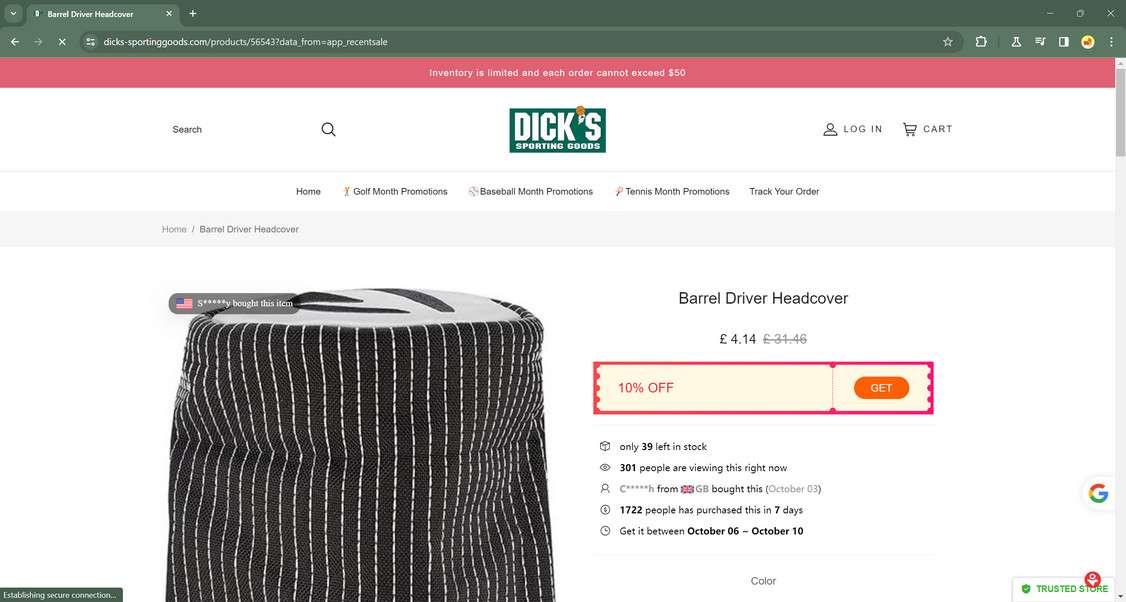Have you seen those tempting ads on Facebook or Instagram promising clearance sales with 90% off top brands at Dick’s Sporting Goods? As unbelievable as the deals seem, this article exposes how they lure unsuspecting shoppers into elaborate scams designed to steal identities and money. Read on to uncover these fraudsters’ deceitful tactics, learn to spot their scammy tricks, and protect yourself from becoming the next victim of these viral hoaxes running rampant across social media. With just a few precautions, you can avoid their clever traps waiting to catch frenzied bargain hunters and score the real deals safely.



This Article Contains:
Overview of The Elaborate Dick’s Sporting Goods Clearance Sale Scam
A cunning scam targeting bargain shoppers is running rampant on social media, luring unsuspecting consumers to fraudulent websites disguised as authorized Dick’s Sporting Goods clearance sales. Savvy scammers are promoting these fake sales through Facebook, Instagram and TikTok ads boasting unbelievable 90% off deals on top brands that seem too good to pass up. However, these remarkable discounts are really just bait used to hook victims into providing their personal information and payment data to criminal sites.
This elaborate hoax works by first capturing attention with compelling ads for warehouse clearances, store closings and liquidation sales apparently offered by Dick’s. Prices like $29 for Nike shoes or $39 for The North Face jackets originally $200+ make the hype highly enticing. Scammers pick coveted, rarely discounted products shoppers crave to drive urgency.

Those who click these ads end up on sophisticated fake Dick’s websites with the company’s official logos, fonts, colors and other branding. To the undiscerning eye, the sites pass as the real deal. However, while the layout mimics a legitimate retailer, critical elements like contact information, physical addresses and SSL security are missing.
After adding improbably marked down items to their cart, victims go through a seemingly normal checkout process entering personal data like names, shipping address and credit card details. But unbeknownst to buyers, this information is being harvested by scammers to commit identity theft and payment fraud.
Shortly after completing a purchase on these fraudulent sites, dismayed shoppers realize the scam when nothing arrives, they receive a cheap knockoff product from China or some random nearly worthless item the scammers had on hand. Any attempts to reach customer support go unanswered, as the email addresses and phone numbers on the sites are fakes. There is no way to contact the scammers, who cover their tracks to avoid getting caught.

By the time victims realize they have been scammed, it is too late. Not only is their money gone, but their personal information has likely been compromised and sold on the dark web. Data like names, addresses and credit card numbers are valuable to criminals who use it to open fraudulent accounts to steal even more funds.
These slick scammers rely on the tempting promise of unbeatable prices on coveted brands to trick frenzied bargain hunters into letting their guard down. But what seems like the discount of a lifetime ends up costing unsuspecting shoppers dearly. Losing their money is just the beginning of the damage that can be done if scammers manage to get their hands on stolen personal information.
This deceptive tactic has surged in popularity due to the reach scammers have on social media platforms like Facebook, Instagram and TikTok. They can instantly get fake clearance sale ads displaying unbelievable prices in front of millions of users. This effectively casts a wide net aiming to catch as many victims as possible.
While savvy social media users know to be cautious of too good to be true offers online, these remarkably convincing fake Dick’s Sporting Goods websites prove tricky even for the wary. By understanding how this scam works, shoppers have a much better chance of spotting the warning signs and avoiding the rip-off. But those who do get hooked still have options to mitigate the fallout, which will be covered later in this article.
Breakdown Of The Fake Dick’s Sporting Goods Clearance Sale Scam Process
While clever scammers try making their bogus sales believable, their deceptive process has some glaring flaws. Understanding each step can help you detect and avoid these risky rip-offs. Here is an in-depth overview of how these fraudsters operate:
1: Bait – Fake Social Media Ads For Clearance Sales
Savvy scammers create flashy Facebook, Instagram and TikTok ads promoting unbelievable clearance sales on Dick’s big brands – Nike, Under Armour, The North Face, etc. Prices seem unreal – $19 shoes marked down from $200, or $39 hoodies originally $250. Taglines tout warehouse clearances, store closings, inventory liquidations or going out of business sales.

This compelling clickbait is designed to capture attention from deal-seeking shoppers. But a close look shows misspellings, strange URLs, and no blue verification checkmarks. Red flags signaling it’s not a real Dick’s ad.
2. Hook – Phony Dick’s Sporting Goods Websites
Clicking these ads leads to sophisticated fake Dick’s websites with the company’s logos, marks and images. The home page shows the same irresistible deals used in the ads to lure you in.

While the site looks convincing, inspecting closely uncovers subtle mistakes, grammatical errors, stolen images and zero About Us, Contact Us or social media links. Prices are unusually low, and selections focus on coveted items rarely discounted that deeply.
3. Reel-In – Fake Checkout Process
Adding items to your cart reveals a seemingly normal checkout process. Even entering payment info appears to work, though credit card processors are spoofed.
But the lack of SSL encryption, contact info, physical address, terms and conditions links should raise alarms. And forgetting an account password takes you to a broken page.
If you don’t pick up on these problems as red flags, you’ll likely complete the misleading purchase believing you scored big. In reality, that data just put your identity and money at huge risk.
4. Catch – Empty Order Or Cheap Counterfeit Product
Days after your “order”, you’ll probably get nothing, or a cheap knockoff, like low quality sunglasses, from China. Or maybe a random inexpensive product the scammers had handy to send.
Either way, you’ll realize it’s a scam and you won’t receive what you bought. But by then, it’s too late – your money is gone, your personal information compromised.
5. Release – Vanishing Act By Scammers
Back on the fake site, you see no way to contact support. Chatbots fail. Email bounces back. Phone numbers don’t work or go to voicemail. There’s no physical address or company info.
You got played by sophisticated scammers who cover their tracks carefully to avoid getting caught. They already cashed in on stolen data and vanished without a trace – along with your hard-earned money.
That’s the sinister playbook these clever fraudsters follow to successfully rip off consumers. But being aware of each step can help you detect and divert from their devious traps.
Identifying Fake Dick’s Websites – Warning Signs To Watch For
While the scam Dick’s Sporting Goods websites may look convincing at first glance, a closer inspection reveals many red flags indicating their fraudulent nature. Being able to recognize these signs is crucial to avoid being hooked by these deceptive deals. Here are the top warning signs to watch out for:
- Misspellings/Grammatical Errors – Sloppy writing full of typos on product descriptions, headings and other content indicate an amateur scammer, not a billion-dollar corporation.
- Suspicious URL – Fake sites use a URL designed to mimic the real website. But lookalike urls with extra words or letters signal a shady imposter site.
- No SSL Security – Authentic sites use SSL encryption (https://) to protect data entered. HTTP connections don’t encrypt info, putting your data at risk.
- No Verified Checkmark on Social Media – Legitimate Dick’s social media pages and ads have a blue verification check. Lack of this proves the ad is fake.
- Too Good to be True Pricing – Real sales rarely offer more than 25-30% off. But these scam sites boast up to 90% off deals that are just too good to be true.
- Bait Buzzwords – Scams use enticing slogans like “store closing sale” and “clearance sale” to create false urgency to buy before the deals vanish.
- No Contact Information – Missing phone numbers, physical addresses and live customer service indicate a shady seller you can’t contact if issues arise.
- No Company Details – Without About Us or Contact Us pages, these faceless sites hide who is really behind them.
- No Reviews or Ways to Ask Questions – If you can’t read feedback or ask questions, you can’t validate quality and legitimacy before purchasing.
- Stock Photos – Slick product images are stolen from other sites since scammers don’t actually have inventory to photograph.
- Broken Links/Pages – Non-working webpages and reset password failures expose incomplete amateur sites built in haste.
- Typosquatting on Brand Names – Subtle misspellings like DicksSportingGoods or DickSportGoods mimic the real site name deceptively.
Staying vigilant for these common red flags can help expose scammy imitators masquerading as legitimate retailers with hard to pass up deals. When uncertain, double check directly with Dick’s Sporting Goods to authenticate tempting offers before purchase. Avoid taking the bait without verification first.
Identifying The Scam Ads on Social Media
In addition to fake websites, scammers promote their bogus Dick’s sales through deceptive social media ads. Here’s how to detect their scammy ads on the top platforms:
Spotting The Facebook Scam Ads
On Facebook, beware ads boasting unreal prices like 90% off on coveted gear using enticing slogans implying limited chance to score big. Warning signs include:
- Extreme low prices, like $29 for Nike shoes marked down from $200.
- Enticing slogans like “clearance sale” and “going out of business” to create false urgency.
- The ad account lacks a blue verification badge. Dick’s verified pages have a blue checkmark.
- Images may be stolen product photos or AI-generated fake images that seem blurry.
- Upon clicking, the destination website URL looks suspicious, not the real Dick’s site.
Identifying The Instagram Scam Ads
On Instagram, scam ads promise blowout deals on top brands in Stories and feed posts. Giveaways are red flags too. Telltale signs of fraudulent Instagram ads include:
- Prices too good to be true, like $39 for a $250 North Face jacket.
- High-demand products like workout apparel and sneakers disproportionately pushed.
- “Limited time only!” and “Going fast, order now!” type slogans pressure you to buy immediately.
- Link in bio goes to an illegitimate lookalike site, not Dick’s real website.
- Limited followers/following, or account was recently created.
Spotting The TikTok Scam Ads
Scammers also leverage TikTok’s explosive reach, using video ads on coveted products. Warning signs to watch for:
- Video promoting deals like 70% off uses AI voice/images or stolen clips.
- No blue check verifying the account – authentication protecting reputable brands.
- Link in bio routes to scam website subtly misspelled to resemble Dick’s.
- Prices suspiciously low for rarely discounted items.
Checking for these indicators can help expose fraudulent social media ads aiming to direct consumers to deceptive websites disguised as authorized Dick’s sales. Avoid taking the bait being dangled on social platforms without verifying legitimacy first.
What To Do If You Already Fell For The Fake Dick’s Sale Scam
If you got fooled by one of these deceitful Dick’s Sporting Goods scams, here are crucial damage control steps to take right away:
- Contact Your Bank – Notify your credit card provider of potential fraud on your account right away. They may be able to stop payments or reverse those already processed.
- Watch Statements Closely – Keep checking statements often to identify any unauthorized charges from your stolen data. Dispute these promptly.
- Change Passwords – Update all account passwords that used the one entered on the fake site to prevent access by scammers. Make each password long, complex and unique.
- Place Fraud Alert – Call credit bureaus to request fraud alerts to warn lenders of suspicious activity on your identity and accounts. This adds scrutiny to applications.
- Monitor Credit Reports – Order credit reports frequently to check for signs of new accounts or loans opened without your approval. Dispute anything suspicious.
- Freeze Credit – Placing a credit freeze restricts access to your credit report, making it harder for scammers to open fraudulent accounts. But this also impacts your ability to obtain credit.
- File Complaints – Report the scam to the FTC, state attorney general, and FBI IC3 to aid investigations working to apprehend the fraudsters behind it.
- Warn Others – Share your experience on social media and consumer sites so others learn about the scam tactics to avoid falling victim too.
- Seek Legal Counsel – Consulting an attorney can determine if any legal action can help recover lost money, remove fraudulent charges, or hold negligent parties accountable. But lawsuits are often expensive with minimal payouts.
By acting swiftly, you can potentially minimize the damage from these convincing clearance sale scams. But your best option remains spotting and avoiding the too good to be true deals in the first place.
Frequently Asked Questions About The Fake Dick’s Sales Scam
1. How can I tell if a Dick’s Sporting Goods sale advertised on social media is a scam?
Look for warning signs like prices that seem too good to be true (90% off), enticing slogans about limited time offers, missing blue verification checkmarks on social media accounts, and destination websites with subtle differences from the real dickssportinggoods.com. Always verify discounts directly with Dick’s before purchasing.
2. What happens if I order from one of the fraudulent websites posing as Dick’s Sporting Goods?
Most likely your order will never arrive. Or you may receive a random, inexpensive item like cheap sunglasses that the scammers use to make it appear your order was fulfilled. Your money will be gone, and your personal information compromised.
3. Could my identity or credit card be stolen if I share information on a fake Dick’s website?
Yes, entering any personal or payment data on scam websites puts you at very high risk of fraud and identity theft. Scammers harvest that information to steal funds or open new fraudulent accounts in your name. Monitor your statements closely.
4. What should I do if I realize I placed an order on a scam website pretending to be Dick’s?
Immediately contact your credit card company to report fraudulent charges so they can be disputed. Place fraud alerts and check your credit reports to detect any suspicious new accounts opened in your name. Change account passwords that may have been compromised.
5. How can I get my money back if I paid for an item on a fake Dick’s website?
Unfortunately, recouping payments made to scammers is very challenging. Notify your bank right away to try stopping or reversing the charges. File detailed complaints with the FTC, state attorney general, and FBI IC3 to aid investigations.
6. Can I tell if a Dick’s Sporting Goods website is fake just by looking at it?
Yes, scam sites have subtle giveaways like different URLs, grammar/spelling errors, unbelievable prices, missing contact info, fake phone numbers/addresses, stolen images, broken links, no SSL, etc. Knowing the warning signs can help spot fraudulent sites.
7. Why are there so many fake Dick’s Sporting Goods websites scamming shoppers?
Scammers capitalize on the Dick’s brand recognition to make their fakes seem legitimate. Deals on coveted items get attention. And niche clearance sales exploit bargain hunter’s impulses to score deals before missing out.
8. What precautions can I take to avoid getting scammed by a fake Dick’s sale online?
Be wary of unbelievable discounts, limited time offers and other tactics creating urgency. Verify deals directly with Dick’s first. Check site details like URL, contact info, SSL, reviews, company info before providing any personal or payment data.
9. Can I report fraudulent Dick’s Sporting Goods websites or social media ads to help warn others?
Yes, file detailed scam reports with the FTC, state attorney general, FBI IC3, domain registrar, social media platforms, etc. to get fraudulent pages removed and aid law enforcement. Warn friends and post reviews describing the scam tactics.
10. What legal action can I take if I lost money to a fake Dick’s website?
You can consult an attorney to review options, but recouping losses through lawsuits is rare. Scammers vanish untraceably. Focus efforts on damage control protecting your identity, accounts, and credit. Prevention by identifying warning signs remains your best protection.
The Bottom Line – Verify Before Buying Deals That Seem Too Good To Be True
Savvy scammers are heavily promoting unbelievable deals on coveted brands to bait consumers into providing their personal data and money to fraudulent sites. Investigating suspicious offers instead of impulsively purchasing can protect you from becoming their next victim.
Carefully inspect social media posts, URLs, design, contact info and other components to detect deceitful sales. Verify discounts with the real retailer if unsure. Avoid sharing sensitive data or purchasing from sites lacking proof of authenticity. Seeking confirmation first, rather than seizing deals blindly, keeps you and your finances safe.
In today’s risky online marketplace, staying vigilant against increasingly sophisticated frauds is essential. But a few prudent precautions can help you evade their devious traps. Following these tips will keep eager










